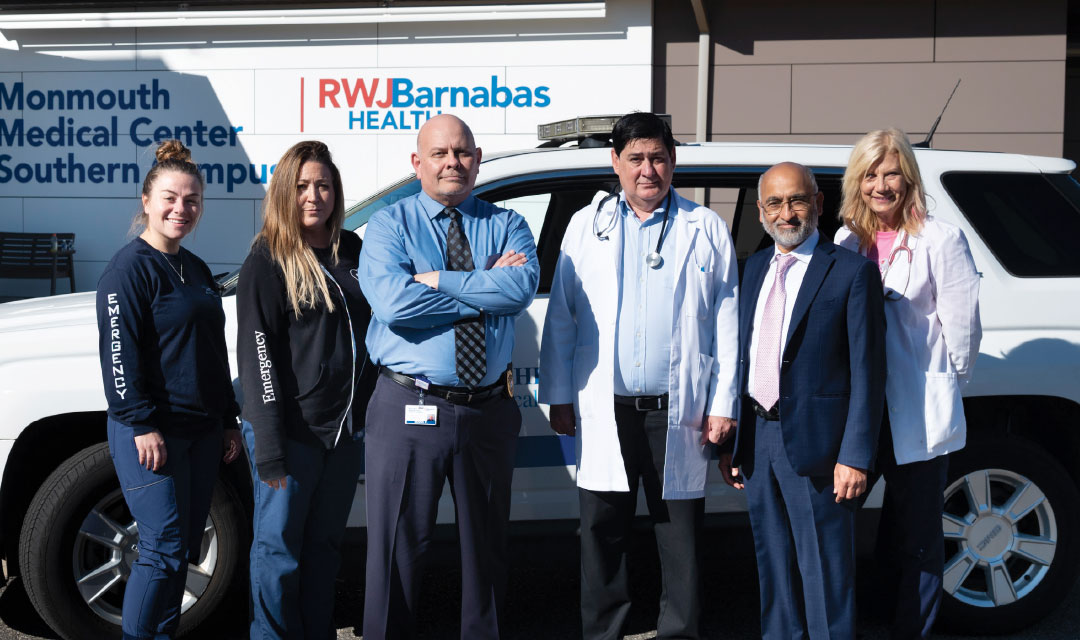“Everybody was great. All the people who responded from the floors and in the ED were fantastic.”

Mark Freiwald was just finishing his shift as Security Supervisor at Monmouth Medical Center Southern Campus (MMCSC) in April 2022 when he began to feel uncomfortable.
“It was around 3 p.m., and I was getting ready to leave about 3:30,” says Mark, 54. “I felt a little warm, so I opened the window to my office, but that didn’t seem to help.”
He went to the men’s room and splashed some water on his face. When he came back to his office, he felt some chest discomfort but didn’t make much of it. Coworkers, however, noticed something seemed off.
“One person was like, ‘Hey, are you OK?’” Mark says. He told his colleagues how he was feeling and said it wasn’t a problem. They danced around the topic.
“Are you sure you’re all right? Maybe you should go downstairs to the Emergency Department [ED] and get checked out.”
“No, no, I’m fine.”
Within a few minutes, Mark was breathing more heavily, and the pain was getting more intense. That’s when coworkers who were keeping a watchful eye on him initiated a chain of care that got him the help he needed.
“They said, ‘We have to get you to the ED,’” Mark says. “So they called a rapid response.” A nurse and hospitalist physician dashed to Mark’s side, and he was rushed to MMCSC’s ED, where doctors determined he was having a heart attack.
Lifesaving Care
“He had a classic presentation of a heart attack,” says Arturo Jimenez, MD, an emergency medicine physician at MMCSC — “new onset of progressive chest discomfort, profuse sweating and heavy breathing that persisted beyond 30 minutes.” EKG readings and a rapid assessment to rule out other conditions confirmed the diagnosis.
Mark was quickly given medications to thin his blood, prevent or dissolve clots, lower cholesterol, stave off abnormal heart rhythms and dilate blood vessels to restore his blood flow and achieve what clinicians call coronary artery reperfusion.
Once he was stabilized, Mark was transported to Robert Wood Johnson University Hospital (RWJUH) in New Brunswick, where he underwent a cardiac catheterization procedure in which doctors cleared a blocked heart artery and inserted two stents to keep it open.
“Our ED team accomplished all the goals of therapy within the proper door-to-reperfusion time, and there was prompt coordination of care with an interventional cardiology team at RWJUH,” Dr. Jimenez says. “It takes a village to recognize a heart attack, treat it immediately and take measures to address the underlying causes.”
Mark’s artery had been 100 percent blocked, severely reducing blood flow to his heart and potentially threatening his life.
“I was very fortunate,” he says of having his heart attack inside the hospital. “Had it been 20 minutes later, I would have been driving home.”
Strength Through Rehab
MMCSC continued to play a critical role in Mark’s heart health. After discharge from a weeklong stay at RWJUH, he recovered at home for a few weeks before returning to work at MMCSC. Shortly after that, he began cardiac rehabilitation twice a week at MMCSC and finished 18 sessions over the summer.
At the Cardiac Rehabilitation Program, he worked out with the treadmill, arm bike, leg press and elliptical machine to get his heart back in shape.
“The entire time, my blood pressure was good, my heart rhythm was good,” he says. “Everything went extremely well. And the staff in cardiac rehab was amazing. They were helpful, friendly, attentive. They were all very supportive.”
Specialists at the program not only help heart attack patients recover but also work with patients who have conditions such as congestive heart failure and stable angina or have undergone heart transplants or heart valve replacements, says Diane Carpino, RN, a cardiac rehabilitation nurse.
Patients typically come to the center two or three times a week to strengthen the heart and establish a fitness routine that they can do on their own when their rehabilitation ends.
“The goal with cardiac rehab is to increase cardiovascular fitness as tolerated,” says Hazelle Meneses, RN, a cardiac rehabilitation nurse. “It’s a process. We start slowly with patients, then build them up while monitoring their hearts.”
Mark improved his strength and endurance during rehab and soon looked forward to working out on his own again at his gym. “I love going to the gym,” he says. “I’m feeling pretty good these days.”
A Grateful Heart
In addition to maintaining his health with exercise, Mark is eating “a little cleaner,” he says, more closely following a reduced-fat, heart-healthy diet. He also takes a cholesterol-lowering medication along with a pill to control hypertension.
He feels grateful for the proverbial village of people who helped with his treatment and recovery, many of whom he works with every day at MMCSC.
“Everybody was great,” Mark says. “All the people who responded from the floors and in the ED were fantastic.” He later spoke with a nurse who took care of him.
“I told her it made me feel better to see that she and other people I’m familiar with were there,” he says. “It was comforting. So even though it was a horrible situation and I was in extreme pain, it was nice that those were the people surrounding me.”
Whoever your heart beats for, our hearts beat for you. To connect with a top cardiovascular specialist at Monmouth Medical Center Southern Campus, call 888-724-7123.